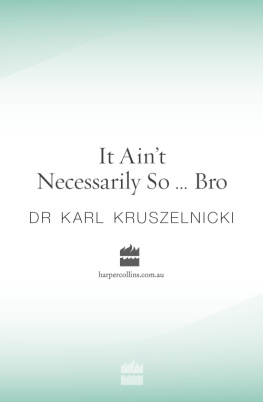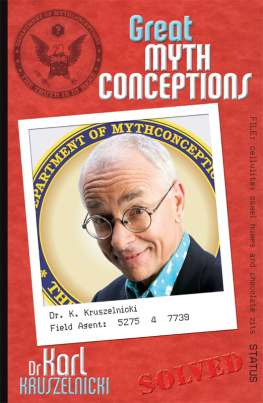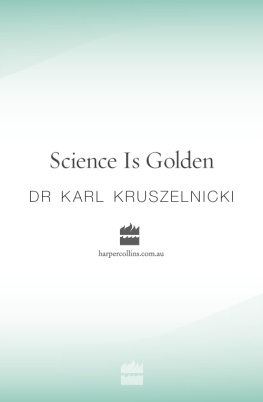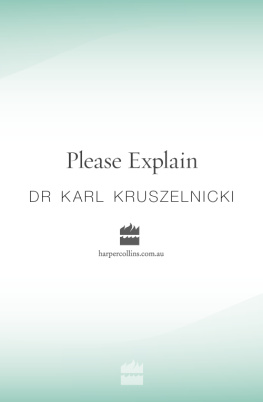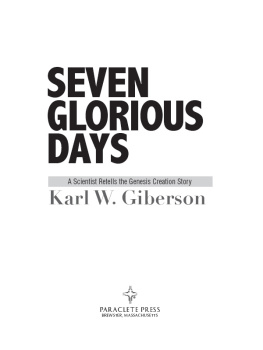This book is dedicated to Pluto, a small compensation for your loss of statusPluto was discovered in 1930 by a farm boywho was in the right place but for the wrong reasons.
We humans have a deep sense of curiosity and want to understand the world around us. One question that we often ask is, How old is our world?. With todays knowledge, science tells us that the Earth is about 4.6 billion years old, but a small number of peoplethe Young Earthersstick ferociously to a belief that our planet is 6000 years old.
History of Earths Age
Back around 400 AD, St Jerome, the Italian scholar and priest, made a 6000-year estimate for the age of the Earth, as did the later scholars, Scaliger and Venerable Bede. Around 1600, in the Shakespearean play As You Like It (Act IV, Scene 1), Rosalind says, The poor world is almost six thousand years old
In the Bible, Psalm 90, Verse 4 reads, For a thousand years in your sight are like a day that has just gone by, or like a watch in the night. In other words, the six Days of Creation could take 6000 years to pass, which would fit in well with the Earth being roughly 6000 years old.
In 1642, Dr John Lightfoot, English minister, rabbinical and linguistic scholar and later Vice Chancellor of Cambridge University in the United Kingdom, wrote his Observations on Genesisa book of some 20 pages. In it, he observed that Man (not the World) was created at 9.00 am. He based this on Genesis, Verse 26, Chapter 1: Man was created by the Trinity about the third hour of the day, or nine of the clock in the morning. Two years later, on the basis of further interpretation of the Bible, he wrote that the Earth was created on Sunday, 12 September 3928 BC. He also estimated that Man was created five days later, on Friday, 17 September.
Ussher, Mega-brain
The Young Earthers use the planet-dating estimate which came from James Ussher (15811665), a gifted linguist and prolific religious scholar.
Ussher entered Trinity College in Dublin at the age of 13, received a masters degree at the age of 20, was ordained as a priest at 21 and appointed Professor of Theology at Trinity when he was only 26. He was also twice Vice Chancellor of Trinity, in 1614 and 1617. In 1625, he was appointed Archbishop of Amargh, and by 1634 was Primate of All Ireland. A prolific writer, he published some 17 volumes. Ussher was a very smart and hard-working dude.
In 1650, he published the first part of Annals of the Old Testament, Deduced from the First Origins of the World in Latin. The second part was published four years later. It was an immense work, covering everything from the creation of the world to the dispersion of the Jews in the reign of Vespasian (6979 AD). Fuller translated the Annals into English in 1658.
How Ussher Did It
Archbishop Ussher used the best of his considerable historical and scholastic skills to deal with the poor historical and archeological records of the time. He also had to deal with the fact that there were several different versions of the Bible, built up from different sources over several centuries. He studied three different time periods.
The first time periodEarly Times: Creation up to Solomonwas the easiest to calculate. The Bible gives a continuous male lineage from Adam to SolomonAdam begat Seth begat Enosh begat Kenontogether with everybodys ages. All Ussher had to do was add the ages together. But there was one minor problemdifferent versions of the Bible gave different ages. So Ussher simply used the Hebrew Bible.
The second time periodEarly Age of Kings: Solomon to the Destruction of the Temple and the Babylonian Captivitywas more difficult. Once the begats ran out, Ussher had only the lengths of kings reigns in the Bible to work with. So he cross-referenced these with the then known historical records to continue his timeline.
In the third time periodLate Age of Kings: Ezra and Nehemiah up to the Birth of JesusUssher had to link individual events in the Bible with the historical records of the relevant societies. For example, 2 Kings 25:27 reads: In the thirty-seventh year of the exile of Jehoiachin, king of Judah, in the year Evil-merodach became King of Babylon, he released Jehoiachin from prison on the twenty-seventh day of the twelfth month. From historical non-biblical records, this can be separately related to Nebuchadnezzar IIs death.
You dont look a day over 4.6 billion years

The simple question of How old is our world? can bring answers ranging from 6000 to 4.6 billion years. Lets go to the adjudicators
Ussher Into Bible
This hard work gave Ussher a date of about 4000 BC for the Creation. The scholars of the day already knew of the counting error that Dionysius Exiguus (Dennis the Small), who set up the AD year counting system, had accidentally made. Thanks to this error, Jesus Christ was probably born in 4 BC. So Ussher added four years to 4000 BC to give 4004 BC as the date when God created Life, the Universe and Everything.
In his Annals, Ussher stated that the world was created on Sunday, 23 October 4004 BC.
The Sunday was easy to calculate. The Bible tells us that God rested on the seventh day, which, under the Hebrew system, was Saturday. Counting backwards to the first day gives us Sunday.
He came up with 23 October by using the slightly incorrect astronomical tables of the day to find the autumnal equinox (when the hours of daylight and darkness are equal). He chose the autumnal equinox because it was the beginning of Jewish calendar year.
In 1701, this estimate for the worlds creation found favour with Bishop William Lloyd of Winchester, who got the publishers, Clarendon Press at Oxford, to insert it in the Great Edition of the King James Bible. They placed his dateswithout authorisation!in the margins of the appropriate pages of Genesis, where they remained for centuries. There are no footnotes or explanations in the Bible to justify how these dates came to be inserted.
The fact that this unauthorised date appeared in the margins of the Bible made it gospel truth for most Christians back then, and for a much smaller percentage today.
Young Earthers
Todays Young Earthersa very small but passionate creationist groupstill use Usshers estimate of 4004 BC. (Their interpretation is at odds with most Christian faiths, including the Catholic Church and the Church of England.) They get around the geological and other scientific evidence with extreme mental gymnastics, by suspending many of the known laws of science.
For example, they claim that in the past the continents drifted at kilometres per hour rather than centimetres per year. They also claim that coral reefs formed at 40 000 times their present rate, that oceans evaporated at 4 m per day to form salt beds, that ocean floor sediments formed at 80 million times their present rate, and so on.
Big It Up for Ussher
Today, many people mock James Ussher. But evolutionist Stephen Jay Gould, who disagreed with Usshers 6000-year estimate, nevertheless respected him as a scholar. He wrote: I shall be defending Usshers chronology as an honourable effort for its time, and arguing that our usual ridicule only records a lamentable small-mindedness based on mistaken use of present criteria to judge a distant and different past.
It is my own personal belief that if Archbishop Ussher were alive today, he would look at the evidence with his keen mind, and happily accept the current 4.6-billion-year estimate of the age of the Earth
Other Religions

